#PHILIPPINES MENTIONED!!!!!
Text

%%% — ABOUT ME!
### BIO : CALL ME RUA! I GO BY SHE/THEY PRONOUNS <3 I’M A FILIPINO, EIGHTEEN YEAR OLD MIGUEL O’HARA APOLOGIST!
### MUSES : MIGUEL O’HARA, HOBIE BROWN, TEARS OF THEMIS CHARACTERS (ARTEM WING, VYN RICHTER, MC, CELESTINE TAYLOR!), JJK CHARACTERS (NANAMI KENTO, GOJO SATORU, ZENIN TWINS, TOJI FUSHIGURO!)

%%% — STATUS!
### THIRSTS/DRABBLES : YES
### REQUESTS : NO
### CURRENT WORKS : FOUR EYES! (NERD!MIGUEL X READER), ONE LAST BACKUP (ANGST!MIGUEL), SCORE! (NSFW!MIGUEL)

TAGS? USE MY FEATURE TAGS! <3 UPDATED: 05/11/2023

#👟 — [DIRECTORIES!]#STILL ROUGH HAHA I’LL FIX IT WHEN THE LOOMING FEAR OF EXAMS GO AWAY#PHILIPPINES MENTIONED!!!!!#yes i also play genshin and hsr#yes i also play cod#yes i love women#and yes i call my men my wives
7 notes
·
View notes
Text

SWAG
165 notes
·
View notes
Text

me when mc from resident lover is canonically Filipino
#art#my art#artists on tumblr#resident lover#RAHHHHHHHHHHHHHHHH#PHILIPPINES ON TOP#💪💪💪💪#ME WHEN SINIGANG IS MENTIONED#ME WHEN HALO HALO IS MENTIONED#ME WHEN LECHON IS MENTIONED#GAME OF THE YEAR GUYS
282 notes
·
View notes
Text
redacted headcanons if they were filipino 🇵🇭
please bear w me and my scattered thoughts😭 also credits to @pandoraroid for the vincent hc it's so real
- when the shaw pack gets together they do the family gathering thing of making the kids have a dance competition for money
- angel doesn't know how to commute (public transportation) and david would have to come along with them on a jeep to help them learn
"davey ikaw pumara para sakin please nahihiya ako" "kaya mo yan, dali lalagpas na tayo oh"
("davey can you make the jeep stop please i'm too shy" "you can do it, cmon we're gonna miss our stop")
- at a jollibee birthday party david would always help the shaw kids win the "bring me game" . that shit is SERIOUS for him i would bet
- milo would overdress all the time . kahit anong ganap he will be layering IN SPITE of the heat. he'd also be called "estetik" and he HATES IT .
(estetik: from aesthetic, used to make fun of people who dress up)
*(kahit anong ganap: whatever event there is)
- also, milo and sweetheart ukay-ukay dates perhaps. . . . but i think they'd both get carried away because they'd be blessed by the ukay gods and forget they were ever on a date
(ukay-ukay: secondhand shops in the ph!! mainly clothes)
vincent and lovely . aircon humor x kanal humor CMAWWNN. the vampire houses alone r so extra and fancy vincent would for sure have the conyo/filipino rich ppl accent too like.
(vin telling lovely abt his first summit): vin: "ok so inisip ko like, paano ako gaganti kay william during the summit, right? so i decided i was going to show up looking like as the, pinaka-antithesis of what he wants me to look like."
lovely, absorbing nothing of what he just said: "HUY antithesis???????"
(vin: "ok so i thought, how am i gonna get back at william during the summit, right?; ...looking like the (most)antithesis of what he wants me to look like.")
(aircon humor: humor associated with wealthy people, priv school kids, "out of touch" humor
kanal humor: "public school humor" , vulgar and relatable
conyo: someone who speaks filo+english in a pretentious way, mostly due to being raised wealthy . idk they always have that rich ppl accent)
- i can't imagine guy being filipino no matter what i do. however, i think honey is for sure filo (projecting) and they wld have a complete filo friend group . honey wld still have that gruff exterior but their walls r down, and their friends would joke that honey and guy r the "nonchalant x oa" pairing and guy wld have NO clue what they're all talkin abt.
(oa: over acting, usually used negatively to call someone dramatic, but with the "nonchalant x oa" it's kinda similar to the introvert x extrovert trope)
- when honey brings guy along to hang out w/ their filo friends, he just looks at them mesmerized 90% of the time they're all talking . afterwards, when they ask abt it, guy says that honey is way more expressive when they speak in filipino and he thinks its rlly cute (IDK. I FEEL THIS ONE IN MY BONES .)
- i also have a hc that honey likes to draw so . stem strand/course to art course pipeline baby (many filipinos can relate🔥🔥🔥)
general idea / kinda just a joke but honestly it'd be so hard to allude to being a vamp in the philippines .
"pag natamaan yung balat ko ng araw, nasusunog ako" "beh nasa pinas ka, lahat tayo nasusunog"
("when the sunlight hits my skin, i start to burn" "beh you're in the philippines, we're all burning")
#if you saw me post this before no you didnt#i may have projected with the honey hcs but we won't speak on it babes#IDK HOW TO EXPLAIN THE LOVELY ONE#its like when someone says a big word#and someone else repeats in a higher tone to make fun of it#because its a word not commonly used in conversation#alam nyo un diba😭#HUYYYYY#redacted audio#redacted asmr#redactedverse#redacted headcanons#philippines mentioned#redacted david#redacted milo#redacted vincent#redacted guy#redacted honey
59 notes
·
View notes
Text
In the spirit of releasing all emotional debts on New Year's Eve, I’m going to open up about my frustrations regarding Desa aka dinosaurusgede aka the creator of Maaf.
For context, she made a Twitter account around the time that Himaruya properly introduced the newly canonized cast of SEA nations (Philippines, Indonesia, Singapore, and Malaysia). Like many other fans, she rode the nostalgia wave in creating content of them. By this point in time, Maaf was more or less a “finished” story to her — whatever Hetalia/SEAtalia content she published from that point onward was not as a continuation of, nor even as a reboot, of Maaf (although she did mention entertaining that idea). For the most part, the newer works she uploaded on Twitter were independent stories and were not necessarily linked to one other either.
Regrettably, I cannot present the problematic page/s for a more thorough and guided scrutiny because she deleted her Twitter account. Unless someone out there saved them, and frankly I wouldn't know who did nor would care to find out, everything was lost to the void. I’m literally working on what was imprinted in my memory by spite, so I apologize if I misremember details.
This will include discussion of anti-indigenous racism and other issues pertaining to colonialism.
She had an IndoPhil story titled Trust Me? and it was inspired by a fanmade BruPhil AMV wherein Indonesia was manipulating Philippines into believing that he was married to Indonesia and not Brunei. Trust Me? kept that concept of a manipulative Indonesia; the key difference being that Indonesia’s motivation for it (in Desa’s story) was the mix of hurt over Philippines “losing his precolonial memories” — based on popularized misconceptions of early Philippine history — of and how that was “aggravated” by his Westernization™, made worse under the United States (350+ years in the convent getting ratio'd by 50 years in Hollywood is hilarious ngl).
That was a lot to unpack, but before we even get there:
Indonesia and Philippines were having a tender moment when HWS America (as in the Hetalia personification that is Alfred F. Jones) walks in calling out "MY LITTLE BROWN BROTHER!"
Indonesia entered his Joker arc because he recalled how HWS America dumped the Philippines in a human zoo at the 1904 St. Louis World’s Fair. There was an explicit panel of Philippines in Igorot* dress and a painfully forlorn bearing.
What "triggered" Indonesia was when, after the flashback, Piri goes up to Indonesia and asks him if he's a Bolshevist 🥺 (the idea was PH being brainwashed by Red Scare propaganda). Cue kabedon moment from Indonesia, and basically a yandere walk down "memory lane."
I did not have it in me to finish reading that comic...
*Igorot is an outdated umbrella term for the upland indigenous peoples of Northern Luzon
Aside from the clearly intended shock value of that depiction, I was taken aback by the painful lack of objectivity on her part when it came to the reading of history. To be fair on Desa, she never specialized in history studies, so it was only courteous that we could not expect her to have as developed of a critical reading as trained academics of history. Unfortunately, that was precisely why I disagreed with the popular notion of Desa as both a great researcher and a great storyteller of her research — all the more when Maaf was just the mangafication of certain Wikipedia articles.
To be fair as well on Wikipedia, it was, at best, a satisfactory jumpstart into more in-depth reading, and we could give it the benefit of the doubt that revisions had since been made to at least some of the articles that Desa relied on while making Maaf (more than 10 years is more than enough time for change). Nevertheless, the articles themselves did not teach users how to scrutinize the sources — most especially the biases of the sources’ author/s — utilized in building up the information.
That mattered because much of the retrospect narratives about the St. Louis Fair had a tendency of raising awareness through the newspaper articles that covered the exhibition at the time. These chronicled the impressions of the visiting authors, who likely (and I say likely because we would have to more exhaustively discern their personal politics one by one) were biased in favor of the “benevolent assimilation” of the Philippines — and the sights that they beheld only validated it further. They did not, however, explain why these Philippine indigenous peoples were brought in in the first place — information that could have further cemented Desa's reputation had she truly spent the efforts, even while understandably juggling other commitments as we all do. Instead, she only perpetuated the habit of sacrificing the veracity of equally important, finer details to the bigger picture in order to sensationalize righteous fury against colonialism.
The 1904 St. Louis World’s Fair was also formally known as the Louisiana Purchase Exposition, giving away its purpose as a commemoration. More appropriately, it was the centennial anniversary (technically delayed by a year though) of the acquisition of French Louisiana, expanding the territorial bounds of the United States. Additionally, the point of a world’s fair was to showcase the achievements of a nation, and one could also think of it as the sale of a fever dream — what more for a fast-growing, fledgling power the likes of the United States, itself a former colony? On another note, the St. Louis World’s Fair was not the only one of its kind so no, the US is not that original lmao.
One could thus see how the inclusion of a dedicated exhibit to the newly acquired colony that was the Philippines neatly fit into the themes of a world's fair centralized on the US. It was all the more a paramount topic of debate, with prominent Americans the likes of Mark Twain (here are selected excerpts, but I highly recommend reading the entirety of his To the Person Sitting in the Darkness) publishing anti-US imperialism opinions, even after the endgame of the Philippine-American War essentially favored the pro-imperialists. While dissent from the American side at the time remains poorly studied AND THAT'S ON OVERRULE BY BIAS, we at least have a glimpse, if mostly obscure still, of its existence.
If we can assume that it must have indeed been a prominent discourse in America, loud enough to get the White House furrowing its brows, then it's plausible to understand how it was of utmost importance that the the Philippine exhibit was to be carefully — because, in a way, America had to sell itself as the "lesser evil" vs notable "rivals" — curated while still ultimately corroborating assimilation of the Philippines. Thus, enter Truman Hunt, the man who oversaw "the Igorot Village" of the St. Louis Fair, having won the hearts of the native Igorots for a powerful reason:
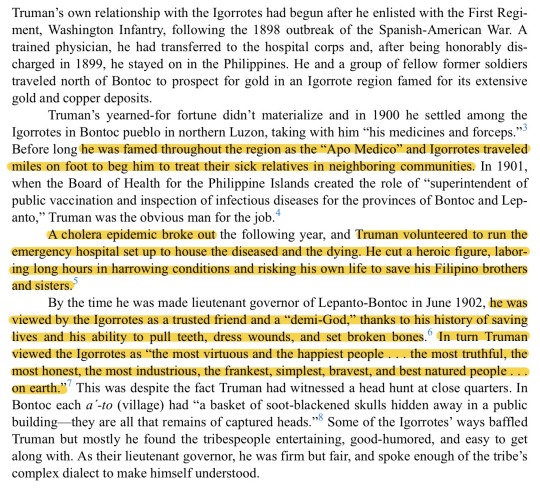
Section from Claire Prentice, The Lost Tribe of Coney Island: Headhunters, Luna Park, and the Man Who Pulled Off the Spectacle of the Century, New York, NY: Amazon Publishing, 2014.
While the cholera epidemic that occurred at the onset of the American Colonial Period was arguably the worst in the history of cholera epidemic management in the Philippines, I want to make it very, very clear that it was not the first and only wave that hit the archipelago. There had been a handful in the prior century alone — all of such magnitudes that it embedded a deep collective trauma; farmers refused to harvest their crops for fear of infection, tragically enabling famines and contributing starvation & nutrition deficiencies on top of a viral & swift killer (the experience of severe, rapid dehydration is such that one can fall dead within hours of infection).
Given such an imaginably harrowing experience (and it was an awfully painful topic to study as someone who got infected with and survived COVID-19 and has family working as frontliners), how could the natives turn away a stranger with such miraculous powers? Who knows how they comprehended it (e.g. a benevolent sign from heaven they must accept) because, unfortunately, we have yet to discuss preserved accounts on that matter, if any at all.
What is known, however, is that there were Igorots who were not just enamored by the "opportunity of a lifetime," but the selected lucky candidates clearly expressed their consent to participate:

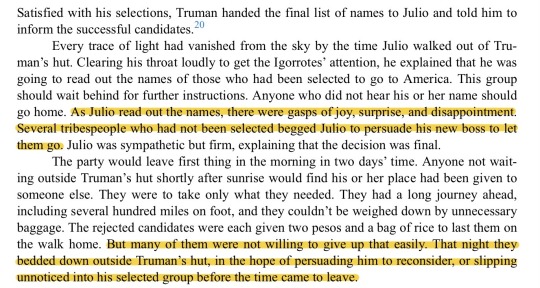
More sections from Prentice, The Lost Tribe of Coney Island.
I will quickly add that, unfortunately, a few members of the Igorot delegation died from illness in making the trip, and Hunt aged like milk over the years (fell into the trap of capitalism in pushing for more subsequent exhibit trips, to the point that less care was extended to the Igorots and he was ultimately arrested for embezzlement). Given that our scope remains to be the 1904 St. Louis Fair, any signs of abuse inflicted upon the Igorots during their stay based on preserved photographs is simply not clear. To assume that they were in a pitiable state would be to enforce a presentist reading that might betray not just their memories & experiences but also their right to self-determination.
EDIT (01/02/24): A good example to demonstrate what I mean in analyzing photographs, here's an article on the author's personal, genealogical research into the Igorots — specifically, the Suyoc — who were at the St. Louis Fair.
It truly is ironic that a Filipino is making these points as if to defend the United States as a whole (no I am not, and if you think I do, lumayas ka). I agree that white people gawking over the peoples of the Philippines with such fascination that borders fetishism warrants all the eye-rolls. At the same time — and it is even more ironic that I am pointing this out as a lowland, Christianized Tagalog based in the metro (not just any urbanized part of the country) — there is a character of patronizing these indigenous communities in the unspoken assumption that their participation is the fault of their ignorance. Pay attention, once more, to the demographics that constituted the Philippine exhibit in the 1904 St. Louis Fair — what kind of "Filipinos" were included and who were left out? There were also Negritos*, Visayans, and Muslims from Mindanao (historically referred to as Moros) in the same event, yet we hardly hear about their experiences. Perhaps it might have to do with how they were considered "more civilized" than these upland groups.
*OUTDATED term (and please blame the Spanish for it); these are the Aeta.
I understand Desa's reservations against US imperialism and sympathies for communities marginalized by Western colonization. I just hope that I was able to clarify as best as I could why I was so taken aback in how she depicted the Hetalia personification of my country the way she did. I agree that, as far as I ever got to interact with her, she is generally very polite and kind. That's why I gave her the benefit of the doubt when she approached me in DM to apologize for how her narrative choice was offensive. As someone who despised red tape in academia, I tried to talk to her about how there were valid reasons as to why the American Colonial Period was considered a mixed blessing, even by PH historians.
Instead, she pulled a complete 180.

She said that — to a Filipino who condemned imperialism (no matter who started it), who also happened to study history as a profession, and was also a Hetalia fan who wants to explore Hetalia narratives differently from what was popularized. Half of the reason was because some fandom takes left a bad taste, like eating a dish with ingredients that even Gordon Ramsay would tell you shouldn’t go together; the other half was because I saw things differently and wanted to express it because why not?
I want to say it's not necessary to bring up something from a private conversation, but I will anyway to reiterate that my issue is not that she isn't nice. Bluntly, however, the way she said those words so formally did creep me out, but ultimately, my issue lies in how her biases have led her into making off-putting takes from time to time. I will not say more, but Trust Me? was not the only Twitter comic by Desa that got bombastic side-eyes.
And if only because Sukarno got dragged in, I felt compelled to briefly debunk that as well: even he initially viewed the United States in a very positive light: “The United States occupies a very distinguished part, a very distinguished place, in the hearts of the Indonesian people.” That was uttered in 1961, and it took a very specific historical context to instigate a complete shift by 1964:
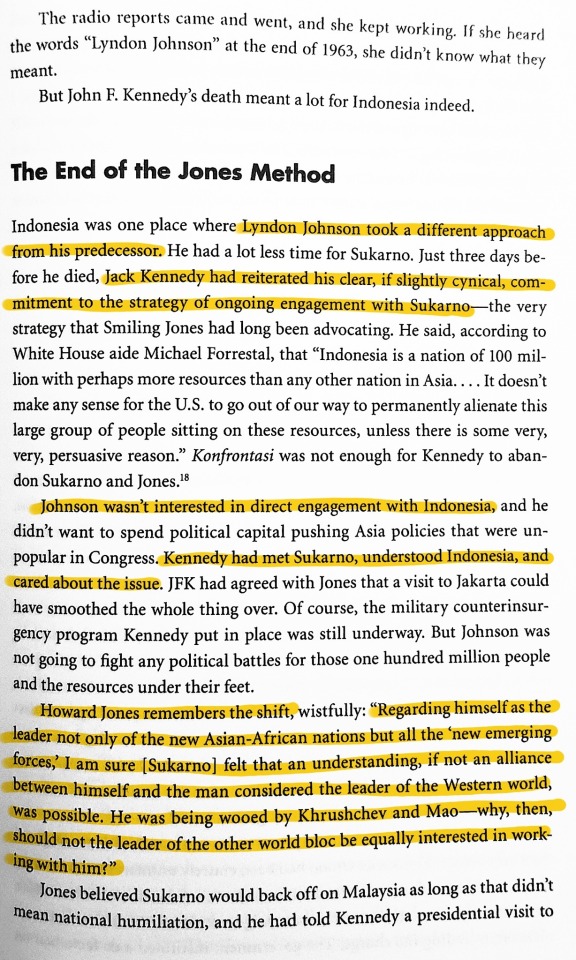
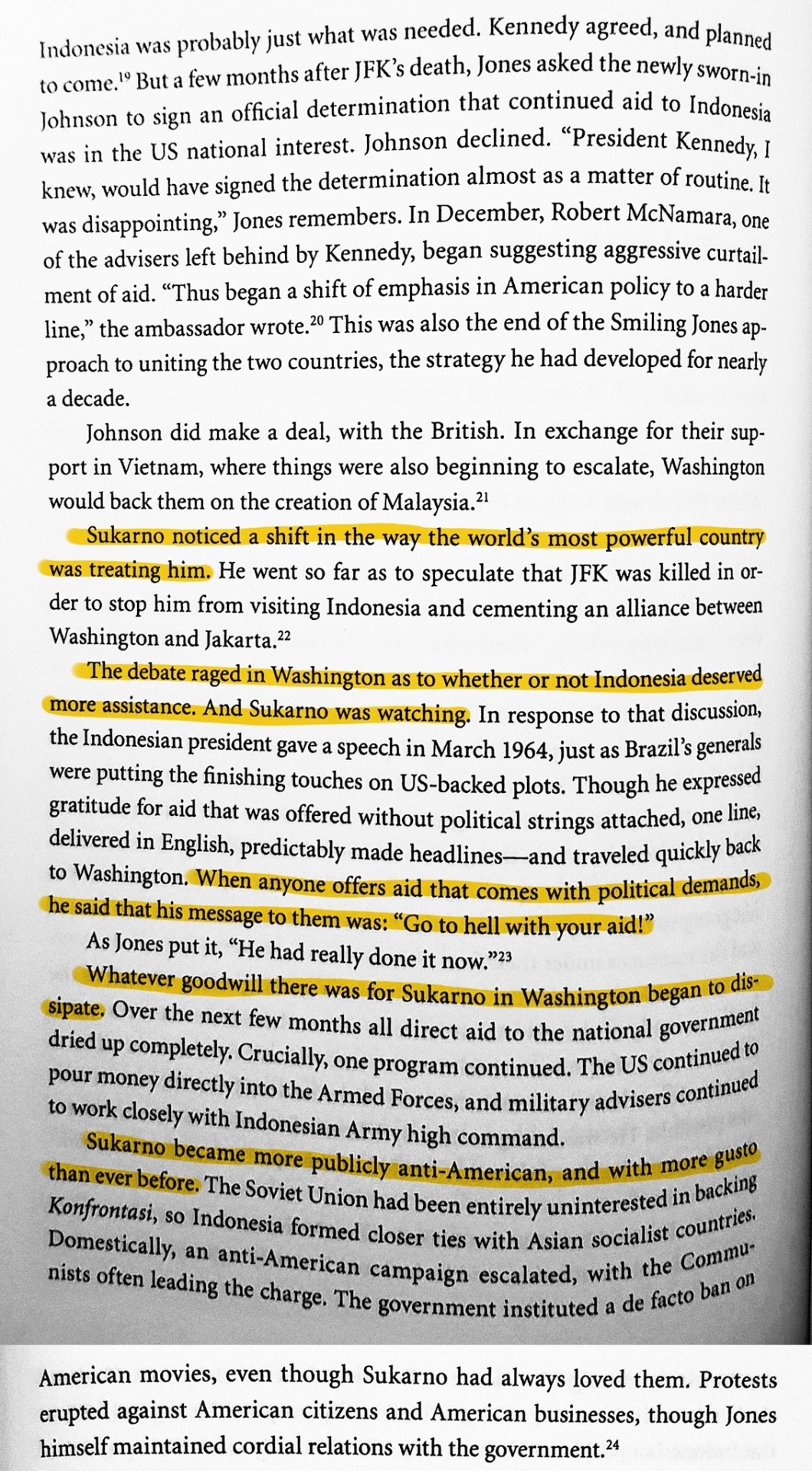
Sections from Vincent Bevins, The Jakarta Method: Washington’s Anticommunist Crusade & the Mass Murder Program that Shaped Our World, New York: PublicAffairs, 2021, 121-123.
EDIT (01/02/24): Note that Desa was citing Sukarno's later sentiments in the late 1960s as her reason for characterizing Indonesia as such in her comic. However, the setting of the story was the late 1920s (Indonesia's visit was based on Tan Malaka's abscondence to the Philippines). I'd dare say the anachronism was not due to oversight but a deliberate choice in using a certain fictional character — namely HWS Indonesia — as propaganda for Desa's anti-Americanism.
It's definitely depressing to think about all the "lost" history & culture that thrived before the arrival of white colonizers. It's why I'm surprised that, for a fiction work, she didn't project all that anger onto Spain instead — it had to specifically be the United States. Was it because they basically cockblocked Philippine independence, even though Spain practically sold the Philippines to the US? The implication that Spain should be permitted to wash its hands clean of all accountability was an awkward message to convey.
I understand that nothing could be 100% accurate (I'm actually quoting Desa defending herself on that matter) in fiction, but the level of projection coming from a certain non-Filipino reading Philippine history was so silly. And again, how did it all justify the explicit depiction of HWS Philippines as an indigenous man in a human zoo? (END OF EDIT)
As my professors will also never tire of saying: you can disagree with a historian’s interpretations but you can never disagree with the evidence in themselves. You don’t have to morally agree either, and I can guarantee you that many Filipinos do not. I, myself, resented the endgame of the particular war that brought that period about in the first place. How dare, then, she said it was “not her place” to defend US imperialism, while granting herself the freedom to express her country’s feelings on the matter?
Oh, it’s all just fiction? I do not condone the subsequent treatment she received, but why then couldn’t she stop trying to “educate” NLID shippers? I do not know how both sides talked to one another, only that what caught me eye was: Why does everyone else have to respect her fiction while she gets to disrespect others’ fictions for not aligning with hers?
EDIT (01/20/24): Just to clarify further on that point — over a decade ago, she went ham in the comment section of someone's (APH) America x (fem!OC) Indonesia. That ship is not in my lore either simply because I follow a totally different route. To cut to the chase, she took that fanart very personally and infodumped on US war crimes that involved Indonesia.
I know Tan Malaka started the whole North Indonesia agenda, but come on, neither was it Desa's place to just treat HWS Philippines the way she did. An Indonesian schooling other Indonesians on ID history is not surprising, but an Indonesian schooling a Filipino on PH history? I'd be humbled if they had the credentials. She didn't and, unless she enrolled herself in a graduate program, she still doesn't.
By all technicalities, she can’t ship IDPH because the Philippine government was (unfortunately and grossly) complicit in the chain of events that led to the 1965-66 genocides in Indonesia. Yet, she does despite of that fact. We thus circle back to Trust Me? and how that was a manifestation of her stubborn refusal to acknowledge any nuances by projecting HWS Indonesia as a self-proclaimed savior of HWS Philippines from the beguile of US neocolonialism.
I empathize with her anger. I'm sorry that the US government by extent enabled what her family went through. I agree that it's not her place to defend them; in fact, she shouldn't. But when even the so-called "highest of Malay nations*" is worth her neutrality, how can she expect me to forgive her?
*That is literally what the Philippines is to her; I know this because she explicitly said so to me in DM. DO NOT ASK FOR RECEIPTS, I am not comfortable revealing that particular conversation.
I cannot — in fact, NO ONE SHOULD — afford to be neutral about Duterte or Marcos, etc., and for her to be so flippant about her privilege (by way of ethnicity/citizenship/cultural upbringing) to be neutral** about Philippine politics, while simultaneously NAGGING ON EVERYBODY TO RESPECT INDONESIAN POLITICS, is annoying at best and plain selfish at worst.
**Also explicitly said to me in DM. Again, DO NOT ASK FOR RECEIPTS.
(END OF EDIT)
I’m not Indonesian but I do not have it in me to politely accuse a native Indonesian of allowing their personal biases to misread their own history. As a Filipino, however, while I'm not surprised by the reductionist chronicling of the histories & cultures of the Philippines, I am at a loss for words over the continuing idolization for Desa & Maaf, when she was not the best and most reliable narrator, especially given her negligence in representing indigenous peoples through her comics.
I mean, guys, I'm not saying this as if the Trust Me? comic was the first and only instance when this was literally Maaf canon that sat comfortably in the internet for over a decade, and continues to be appraised as THE BIBLE OF HISTORICAL HETALIA.
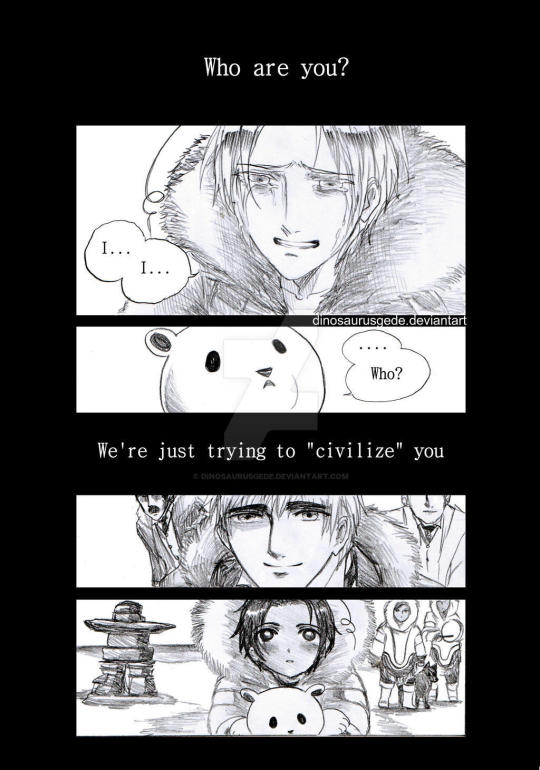

EDIT (01/20/24 — originally added via a reblog): I cannot believe this needs to be said because this is the consequence of when Hetalia fans take their fiction too literally because creators have made careless takes.
There were SEAtalians joking about how the Yolngu are a dead people.
I repeat.

THERE WERE SEATALIANS JOKING ABOUT HOW THE YOLNGU ARE A DEAD PEOPLE.
(END OF EDIT)
So as 2023 comes to a close we enter 2024, I'd like to conclude this post with the following points:
At best, Wikipedia is a satisfactory jumping point, but please believe me when I say no historian will respect you for (over-)relying on Wikipedia. And given that anyone with a decent device & internet signal can access Wikipedia, Desa is just not a GOAT in historical research.
At worst, idolizing Maaf patronizes the work of historians. It doesn't help that PH historians have been targets of harassment because of dis-/misinformation campaigns. I bring this up because it's already bad enough to have to confront that reality outside of fandom spaces on a regular basis in standing our ground for more just historical truths. I hope that folks understand why that's a particularly sensitive struggle for me, and why receiving such comments like the one I shared above deeply hurt. She was not apologetic about that — and every time she would post about apologizing for the moments she has offended others, or when others compliment her for being so open-minded, I cannot help but feel bitter.
Other BIPOC — yes, not just other SEAsians and that's on literally drawing nations other than SEA — have spoken up on the matter. If you can talk about how you learned so much from Desa, you can also learn as much from other perspectives. I hope that in raising all of this, more SEAtalians understand that we risk othering non-SEA BIPOC.
The idolization of Maaf (and the creator in question) is personally far more off-putting than the problematic points of Maaf or any comic she has ever made, because I think she caved to peer pressure instead of learning to wield her fiction more sensitively without being too reliant of the opinions of those she has pleased. Not even Hidekaz Himaruya writes his nationverse characters like that — the one time I’ll admit that canon trumps fanon.
I’m not stopping people from liking Maaf or Desa anyway. I just cannot help but take issue with how the SEAtalia fandom feels less of a safe & inclusive community than it is a cult centered on one person — almost as if her fiction is unquestionable canon and anyone who disagrees gets the boot. Once again, I do not condone the subsequent treatment she received in retaliation, but frankly that's just not what I'm addressing here.
I'm also not saying it's wrong to give words of reassurance and validation to people you admire, only that some of you need to understand you're forcing a parasocial relationship with your idols. It may feel good to you, but please be mindful of the unwarranted pressure it imposes.
I apologize for dumping all of this at literally the end of the year. I want to let it all go in a manner that is clear, concise, and not overwhelming to digest. I do hope that my candid thoughts will push the fandom one step forward in critically consuming media without having to resort to crab-mentality tendencies — because it's been especially hard seeing the demeaning takes made about the Philippines in this fandom.
#hetalia#historical hetalia#hetalia critical#racism cw#hws philippines#aph philippines#hws indonesia#aph indonesia#hws america#aph america#mentions of death cw#sibuyas
47 notes
·
View notes
Text

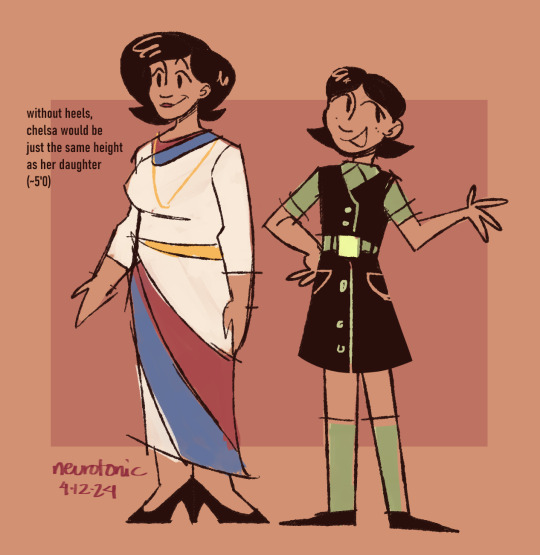
hello chelsa nation . if you guys exist please give me a sign
#i expect you to die#ieytd#i expect you to die 2#ieytd 2#chelsa magpantay#chancellor magpantay#mina magpantay#ieytd ocs#gene ocs#gene art#this is such a little thing to get so excited for#considering she doesnt have much screentime#but i love yelling PHILIPPINES MENTION🔥🔥🔥💯💯💯🇵🇭🇵🇭🇵🇭#whenever i see some smidge of representation in a place i wouldnt expect#however im still kinda. unsure how to write her for now#i'll look into her voicelines again but im having a hard timee looking through#the files#some of the world leaders - pres. okafore.. pm markopoulos and prem. sucre#have some lines . will update when i find more of chancellor#also btw 'gene 5'0 feels way too short' do Not underestimate#how short filipino women can be. teens are too tall these days#i think it's the same back then
25 notes
·
View notes
Text
i would like everyone to know that i cited bill nye the science guy in my research paper and my research advisor did not bat an eyelash
#mostly bc nobody knows who the fuck he is in the philippines#i mentioned him again during my final defense this afternoon#it’s about using organic textiles as alternatives to synthetic cotton in face mask production#then i realized the absurdity of me explaining how he contributed to the rrl to the panel via MS TEAMS
31 notes
·
View notes
Text

Q from XO kitty is literally so kon to me
69 notes
·
View notes
Text

#pinoy gang#philippines mentioned#philippines#visual novel#renpy game#otome game#renpy#vn#vndev#indie game#renpy visual novel#interactive fiction#lavendeerstudios
32 notes
·
View notes
Text
Simbang Gabi: The 9 Days Before Christmas
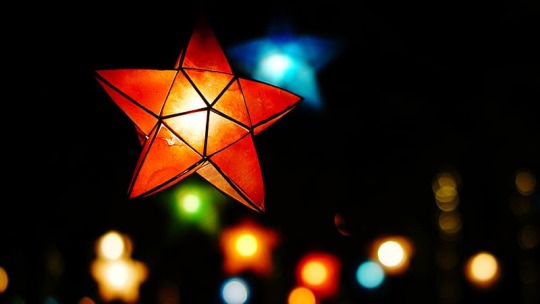
An image of a red parol from Peakpx.com
The Philippines is well-known for its extremely long Christmas celebration that a lot of foreigners often look at with confusion. Traditionally, Filipinos may start putting up their trees, playing festive songs, and counting down to the 25th as early as September in a season that's colloquially called the "ber months" or the "ber months season" (Petrelli, 2021). This period often lasts up until January or February where some houses may still keep their trees and decor pushing as far as March.
Even with this technicality, however, you'd be hard-pressed to find Filipinos truly celebrating from the very beginning of September genuinely ending it by the end of February. Most often, actual celebrations start after Undas, a period encompassing All Saints' Day and All Souls' Day on the 1st and 2nd of November respectively to commemorate the dead, similar but a lot more subtle than other Catholic countries own Day of the Dead like in Mexico's Dia de Los Muertos and Italy's Giorno dei Morti. This time period is often the start of people doing more Christmas-y things such as Kris Kringle activities leading up to the main Christmas party.
The main markers of the true start in itself is the Advent season, which starts on the Sunday nearest to the 30th in Western Churches like Roman Catholicism and leads up to Christmas ("Advent", n.d.). This is where Catholics would go to Church every Sunday leading up to Christmas to light the Advent Wreath until the final candle on its center on Christmas day on the 25th. As the Philippines is heavily influenced by Roman Catholicism, Filipinos follow the Western start of Advent and most celebrations often fall in the middle of this time period. Even the middle of Advent, however, Filipinos have a waiting period to count down before Christmas - Simbang Gabi.
What is Simbang Gabi?
Simbang Gabi (en. night mass; going to mass at night) is a Philippine Christmas tradition wherein Roman Catholic Filipinos would attend mass nine days every single morning or night before the actual Christmas celebration. Traditionally, the masses were held every morning at 4:00 AM from the 16th to the 24th which would then be capped off by Christmas Eve Mass at night or Christmas Mass on the 25th with its early schedule earning it the name Misa de Gallo (en. mass of the rooster) (Lazaro, 2020). In most dioceses, however, they often have an anticipated mass schedule that start a night earlier than the morning masses (Hermoso, 2022).
Besides being called Misa de Gallo, I had also heard the celebration being called Misa de Aguinaldo (en. mass of gifts) in some places. This shares the same name as the similar Puerto Rican tradition Misa de Aguinaldo which is also a nine-day mass held in the morning, typically at 5:00 AM which is also deeply-rooted in Puerto Rican Christmas traditions (Álvarez, 2018).
History
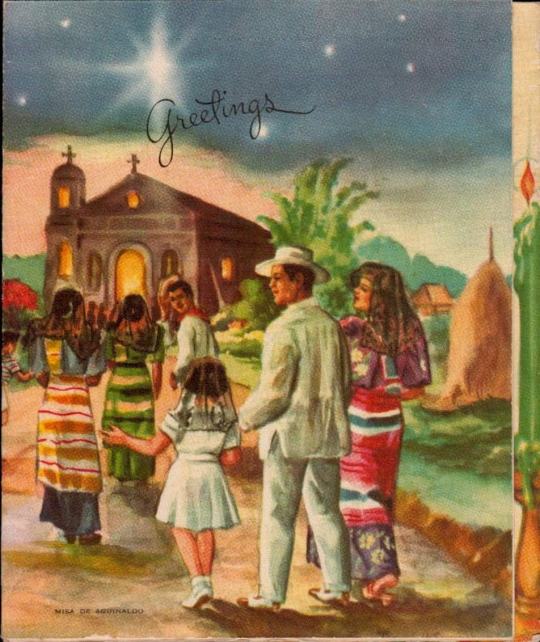
A vintage greeting card posted by the Facebook group Vintage Philippine Islands 1920-1959 (2020)
Being a Christmas tradition, it is not surprising that Simbang Gabi could trace itself back to the Spanish colonial period.
A common misconception of its origins states that the practice first started in Mexico. Hermoso (2018) states that it started on the year 1587 by Friar Diego de Soria of the Convent of San Agustin Acolman when he requested the Vatican to allow church service to be held outdoors because of an overflow of attendees during the Christmas time. Pope Sixtus V later approved of this request and even decreed that these kinds of masses be held in the Philippines at the dawn of the 16th of December. What this doesn't account for was that the practice of going to church for the Eve of Christmas dates back to even earlier than the 16th century.

The cover for an English translation and compilation of Etheria's writings by M.L. McClure and C.L. Feltoe, D.D. (1919)
The first recorded instance of Christians celebrating Christmas by going to early mass leading up to the actual date was first written by Egeria (also called Egeriae, Etheria, or Aetheria), a Christian Galician woman who first recorded it during her travels to the Levant where she notes the early morning masses and festivities from the time of the Epiphany to the Nativity. She writes in her letters later called the Itinerarium Egeriae (en. The Travel Guide of Egeria; The Pilgrimage of Etheria).
"Octave of the Festival.
On the second day also they proceed in like manner to the church in Golgotha, and also on the third day; thus the feast is celebrated with all this joyfulness for three days up to the sixth hour in the church built by Constantine (...) And in Bethlehem also throughout the entire eight days the feast is celebrated with similar festal array and joyfulness daily by the priests and by all the clergy there, and by the monks who are appointed in that place (...) and immense crowds, not of monks only, but also of the laity, both men and women, flock together to Jerusalem from every quarter for the solemn and joyous observance of that day."
- Egeria, 381-384; The Pilgrimage of Etheria (trans. McClure & Feltoe, 1919):
The practice of attending early morning masses up until the main festivities of the Nativity was later adopted by more Western Christian communties during the time of Pope Sixtus III when he celebrated what is widely considered the first Midnight Mass at the Basilica of St. Mary Major in Rome, not only stemming from the popularity of the Christians from Jerusalem but also the popular belief that Jesus was born at midnight (The Pillar, 2021).
The prayer spoken within the midnight vigil was then called the "mox ut gallus cantaverit" which translates to "when the rooster crows", aptly named because of the early hours the vigil tended to last which then coincided with the crowing of roosters ("Misa del Gallo: origen, historia y por qué se celebra en la madrugada del 25 de diciembre", 2022). The practice was continued by the Spanish with the name Misa de Gallo (also called Misa de Aguinaldo)which later spread throughout the Spanish Empire and could now be seen practiced in countries like Bolivia, Puerto Rico, Venezuela, and of course the Philippines.
There seem to be two variations of this: the nine-day series of masses before Christmas (found in the Philippines, Puerto Rico, and Venezuela) and the single early morning mass before Christmas day (found in Spain and Bolivia). It isn't clear if Spain and Bolivia simply dropped the nine-day tradition or if the nine-day tradition was restarted in these other colonies, however.
In the Present Day

An image of crowds outside a church during Simbang Gabi uploaded to Wikimedia by Erwin Malicdem
Today, the Simbang Gabi continues to be a popular tradtion for most Filipino Roman Catholics, even those who aren't typically as religious most parts of the year. This is given the fact that a popular belief is that when a person completes all of the nine days, they may receive a wish to whatever they desire. This is such a common belief that Bishop Broderick Pabillo, a Manila auxiliary bishop, had to remind people that the point of the tradition is to remember Jesus and his nativity (Punay, 2016). Besides this, it is also a common challenge among Filipinos to try to complete it as is or see how many days out of the nine could they actually attend.
It is not uncommon for churches these days to hold an "anticipated" mass the night before the actual date starting instead on the 15th and ending on the 24th with a Christmas mass, instead of starting on the 16th and ending on the 25th. This newer tradition had come from the reign of Filipino dictator President Ferdinand Marcos Sr. during the Martial Law years in the 70s, when Filipinos were not allowed to go out after a curfew until 4 in the morning (Macairan, 2023). This allowed more people and especially those who may not be able to start their day early or those who may have other obligations in the morning to attend masses at night time, typically at around 6 PM - 8 PM.
The only large controversy that I could remember about Simbang Gabi was back in 2011 when the event was banned from being conducted within the Philippine Center in New York City. The ban came about because of it supposedly violated Canon Law which prohibits religious worship in unconsecrated ground or in other words places that aren't seen as places of worship. In an article by Adarlo & Pastor (2014), Rev. Dr. Joseph G. Marabe, the at-the-time head of the Chapel of San Lorenzo Ruiz and a priest-in-residence at St. Patrick's Cathedral where the ban took place, explains in an interview with news site The FilAm:
"It’s not allowed by law to have Holy Mass in an unconsecrated place. Worship should take place in a sacred place. That was an explanation but not a decision. The Archdiocese decides."
- Rev. Dr. Joseph G. Marabe, head of the Chapel of San Lorenzo Ruiz in Chinatown, New York (2011)
The ban was later lifted on 2014 after community leader Loida Nicolas Lewis wrote a letter to the diocese to reconsider the ban which led to the return of the almost 30-year-old tradition that year (Balitang America, ABS-CBN North America Bureau, 2014).
Besides being a huge part of current traditions, a lot of Filipinos, and especially Filipino youth, use the event as an excuse to go out during the night to hang out with friends and even go on dates with their partners. It is not an uncommon sight to see a group of teenagers, often wearing maybe less than typical church clothes, by the edge of the Church seemingly attending mass. Whether or not they're actually being attentive is hard to decipher. Either way, this has led to an explosion of memes almost every year just mocking these kinds of people or making fun of their own.

A screenshot of the "Simbang gabi starter pack" posted by user rhapido on 9Gag.com (2022)
Earlier versions of this meme could be seen posted throughout Filipino social media during the early 2010s

A meme posted by the Facebook page FEU Memes (2012)
The barkada (en. friend group) going to Simbang Gabi had been an older tradition that has found a lot more popularity in the contemporary era because of social media. My mother had told me that she used to use it as an excuse herself back in the 80s to hang out with her friends at night time. This may be a continued past time for especially younger people for years to come.
There's also many street foods associated with Simbang Gabi that may not be unique to the event itself but are nevertheless heavily associated with the event due to their widespread sale during this time period. Foods like bibingka, puto bumbong, kutsinta, and other popular rice cakes dominate the scene which definitely satisfy the hungry parishioners who had, most likely, not eaten breakfast or dinner before going to church. With their strong associations with Simbang Gabii and Filipino Christmas as a whole, I might discuss these on a later date.
Simbang Gabi, from my experience
Growing up and living in the Philippines and especially being raised Catholic within a Catholic town named after a Catholic saint and going to a Catholic school named after another Catholic saint, it probably won't shock you that I, myself, had tried to complete the nine days of Simbang Gabi myself. I had attempted it several times with only maybe trying seriously by myself once in my life. It was quite the experience to just try to dedicate yourself into completing a goal to do something for nine consecutive days straight.
My first attempt was when I was in Junior High and it was with my sister and two people who worked for my parents and had helped watch over us. It was something that I always wanted to try doing and especially since I was gaining a lot more independence at the time so what better to try it out without the rest of the family? With adult supervision, of course.
Since we lived quite away from the actual church, the place was already packed even an hour before the actual mass started. There was barely any seats left and even less standing room leading to a huge overflow of people stuck outdoors, only hearing mass from the outdated speaker system that they had erected in place of the old bell tower.
The mass in our church was often done in the dark during the night out of an deliberate and probably aesthetic choice with only the alter being illuminated by the lights. The rest was lit up by the scattered about Christmas decor throughout the church and the church patio. It always felt like going to some liminal space that other nights at church just doesn't give.
Once the mass has been concluded, people rush out of the doors in thick crowds to find their way into the footpaths leading on to the main town streets. Some opt to stay behind to enjoy the food stalls that had pop-up for the night to eat bibingka, puto, sapin-sapin, and palitaw among other things. Some of the teens had decided to raid the nearby small park and playground as a hang-out spot to talk the night away before they rush home for their curfews. Meanwhile others were just rushing to get home as soon as they can, with people lining up to go to the rudimentary parking space that the church created while the others who didn't own their own vehicles forced to compete for the very few commuter vehicles still riding through the night, hunting for passengers.
This was before we had our own car, so we were with the latter crowds of people, trying to peer through the dark streets only illuminated by the scant Christmas lights that still refused to turn off as the night progressed. Every so often, two headlights excite the crowd and a swarm of them start running in anticipation with not care or tact if they would crush children or separate families all to take a seat on the night jeepneys, some the few commutes left after 9.
My sister was an expert in finding her way through it, reaching out to the doors to form a barricade for herself and the rest of us to prevent others from taking our seats before letting herself in. I still think I would've been left behind if it weren't for her doing that out of sheer competitiveness with the crowds.
We settled into our seats and squeezed in tightly to allow other passengers in so we could all go home as soon as we can. It was a tight but otherwise uneventful commute every night with nothing but tired people waiting for their stops and slowly emptying the once packed vehicle. Since we live in the outskirts of the town, we were often the last few and at times, the drivers would transfer us to other jeeps just so they can go home themselves. This had sometimes instead left us to walk the remainder of the way there through unpaved highway sidewalks.
After a few nights of it, I became more and more reluctant to continue because of the frenzy that it had almost every single night and it was extremely inconvenient for my time and the time of those with me. I didn't complete it then and I hadn't seriously tried until 9th Grade, which honestly was more uneventful.
That attempt was mostly my siblings and I staying in Makati City and Taguig City and going to easily traveled to churches that we could walk to by foot, and high-end malls that have annual Simbang Gabi masses for their shoppers, facilitated by the local diocese and the local fancy church. I was able to complete those easily because I was often dragged either by my siblings or my grandmother who used to never miss a day of church when she was still more active.
It was less about the challenge at that point and more of an obligation which isn't a bad thing and honestly is probably closer to how it should be celebrated.
I hadn't gone to Simbang Gabi since 2019 and I don't have any plans to try this year either. Not really because I don't want to necessarily, but specifically because I physically can't. I still think its pretty fun to do and honestly maybe a good excuse to meet with my friends that I haven't seen in a while. Sadly, I just simply cannot do it now nor in the near future.
Maybe one day I could once again go out at those cold December night to meet my friends and maybe eat some bibingka on my way home but I guess I'll just leave every one else to it.
Sources
Introduction
Advent. (n.d.). In Britannica. Retrieved on 13 December 2023, from https://www.britannica.com/topic/Advent
In The Philippines Christmas Eve Includes A Late Night Street Food Feast, Filipino Christmas, HD wallpaper [image]. (n.d.). Peakpx. Retrieved on 15 December 2023, from https://www.peakpx.com/en/hd-wallpaper-desktop-wxdle
Petrelli, M. (2021, December 20). The country that celebrates Christmas for more than 4 months a year. CNBC. Retrieved on 13 December 2023, from https://www.cnbc.com/2021/12/21/philippines-the-longest-christmas-celebrations-in-the-world-.html
What is Simbang Gabi?
Álvarez, F. (2018, November 22). Una tradición matutina la Misa de Aguinaldo. Primera Hora. Retrieved on 13 December 2023, from https://www.primerahora.com/noticias/puerto-rico/notas/una-tradicion-matutina-la-misa-de-aguinaldo/
Hermoso, C. (2022, December 15). 9-day ‘Simbang Gabi’ begins on Dec. 16; anticipated masses to begin tonight. Manila Bulletin. Retrieved on 13 December 2023, from https://mb.com.ph/2022/12/15/9-day-simbang-gabi-begins-on-dec-16-anticipated-masses-to-begin-tonight/
Lazaro, J. (2020, December 11). The Christmas tradition of Simbang Gabi: After five centuries, this Filipino Christmas tradition lives on. U.S. Catholic. Retrieved on 13 December 2023, from https://uscatholic.org/articles/202012/the-christmas-tradition-of-simbang-gabi/
History
Hermoso, C. (2018, December 15). ‘Simbang Gabi’ a manifestation of the Filipinos’ strong faith in God, says bishop. Manila Bulletin. Retrieved on 13 December 2023, from https://mb.com.ph/2018/12/15/simbang-gabi-a-manifestation-of-the-filipinos-strong-faith-in-god-says-bishop/
Etheria (1919). The Pilgrimage of Etheria (McClure, M., & Feltoe, C. Ed. & Trans.). Society for Promoting Christian Knowledge. Retrieved on 13 December 2023, from https://www.ccel.org/m/mcclure/etheria/etheria.htm (Original work published 384 C.E.)
McClure, M., & Feltoe, C. (1919). [An image of the book cover of "The Pilgrimage of Etheria"]. Retrieved on 15 December 2023, from https://www.ccel.org/m/mcclure/etheria/etheria.htm
The Pillar. (2021, December 21). What time is Midnight Mass?. The Pillar. Retrieved on 15 December 2023, from https://www.pillarcatholic.com/p/what-time-is-midnight-mass
Misa del Gallo: origen, historia y por qué se celebra en la madrugada del 25 de diciembre. (2022, December 24). Marca. Retrieved on 15 December 2023, from https://www.marca.com/tiramillas/actualidad/2022/12/24/63a6c106268e3e7c468b45e8.html
Vintage Philippine Islands 1920-1959. (2020, December 25). A Vintage Greeting Card showing Philippine Christmas… Maligayang Pasko from Vintage Philippine Islands 1920-1959 [image]. Facebook. Retrieved 15 December 2023, from https://www.facebook.com/510513375695362/photos/a.1701322009947820/3595821097164559/?type=3
In the Present Day
Adarlo, S., & Pastor, C. (2014, November 3). Fr. Joseph Marabe breaks silence over Simbang Gabi ban (Part 2). The FilAm: A Magazine for Filipino Americans in New York. Retrieved on 15 December 2023, from https://thefilam.net/archives/16127
Balitang America, ABS-CBN North America Bureau. (2014, September 19). Simbang Gabi returns to NYC after a brief ban. ABS-CBN News. Retrieved on 15 December 2023 from https://news.abs-cbn.com/global-filipino/09/19/14/simbang-gabi-returns-nyc-after-brief-ban
FEU Memes. (2012, December 15). eto yung mga madalas ko makita sa gilid ng simbahan e [image]. Retrieved on 15 December 2023 from https://www.facebook.com/PIYUMEMES/photos/a.210778985704527/317211885061236/?type=3
Macaira, E. (2023, December 15). Simbang Gabi: It’s the mass, not the time. Philippine Star. Retrieved on 15 December 2023, from https://www.philstar.com/headlines/2023/12/15/2318980/simbang-gabi-its-mass-not-time
Malicdem, E. (n.d.) The Bamboo Organ Church or the St. Joseph Parish Church of Las Piñas City in the Philippines during "Simbang Gabi" or Night Mass on Christmas eve. Photo was part of Schadow1 Expeditions coverage of Las Piñas during Christmas season. [image]. Retrieved on 15 December 2023 from https://en.wikipedia.org/wiki/Simbang_Gabi#/media/File:Las_Pinas_Church_during_Simbang_Gabi.jpg
Punay, E. (2016, December 19). ‘Simbang Gabi’ won’t grant wishes – Bishop. Philippine Star Global. Retrieved on 15 December 2023, from https://www.philstar.com/headlines/2016/12/19/1654920/simbang-gabi-wont-grant-wishes-bishop
rhapido. (2022, November 30). Simbang gabi starter pack [Screenshot]. 9Gag. Retrieved 15 December 2023, from https://9gag.com/gag/a5Xnzgr
#mayaposts#mayapino#philippines#filipino#history#philippine history#filipino history#christmas#filipino christmas#philippine christmas#simbang gabi#misa de gallo#misa de aguinaldo#long post#very long post#christianity#catholicism#roman catholic#christian history#food mention
21 notes
·
View notes
Text
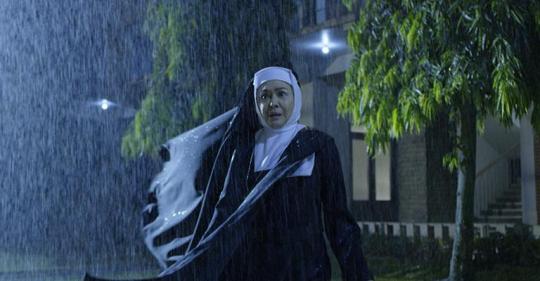
SUMMARY: A guidance counsellor's special talents help her unravel the mystery behind the unexpected and gruesome death of a student at a Catholic school for girls.
#eerie (2018)#supernatural horror#ghost#2010s#philippines#asian movie#mentionable warning#suicide#horror#movies#poll#more than 50% havent heard
12 notes
·
View notes
Text
Pandaguan and the Shark

"Once upon a time, people never died. One day, a fisherman named Pandaguan caught a shark, which died. He became distraught and cried loudly in confusion. The god Kaptan became annoyed by his noises and struck him down with lightning. Pandaguan became the first man to ever die."
I first read this story when I was 6. The art is inspired from Adarna Books' illustrated book of the tale. I first drew it for the Legend prompt of Inktober 2019. Pandaguan's clothes and tattoos are copied from an illustration of tattooed Visayan men on the Boxer Codex .
The Aswang Project has used this art for their article on Pandaguan's wife Lubluban. Check it out!
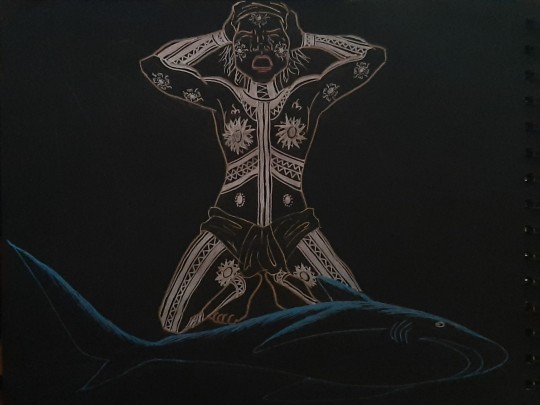
#traditional to digital#digital art#traditional art#black paper#death mention tw#death cw#aeshna's art#philippine mythology#filipino mythology#visayan mythology#pandaguan#death mythology#shark art#alamat#kamatayan
27 notes
·
View notes
Note
First, i'm interested to know these, ❤️ for 🇲🇾 🇹🇼 🇲🇽 💙 for 🇻🇳 🇧🇳 (or all ❤️ ( ͡° ͜ʖ ͡°))
1/5 - Brunei
[Separated these into individual comics hehe, more incoming soon]

. . . Isn't this supposed to be a friendly date. . . ?
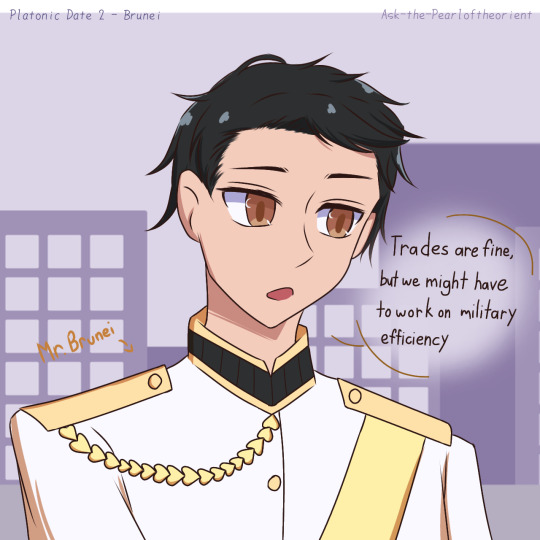
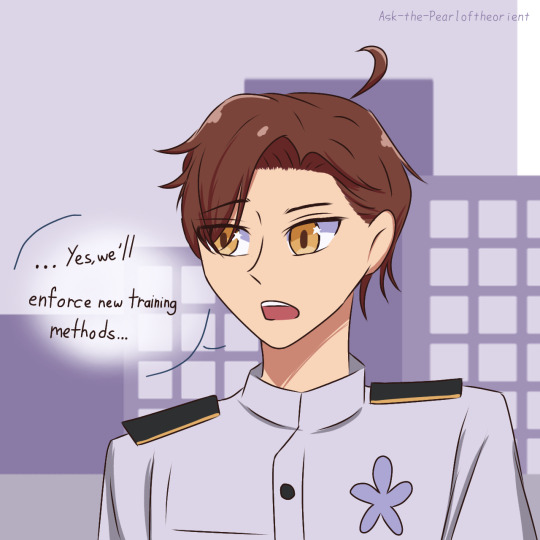

[Tried finding some relations Brunei had with the Philippines but all that shows up is their military partnerships and work stuff, so this is awkward]

[Bonus! GerIta having a shopping date in the bg]
#ask-the-pearloftheorient#Did I mention I love GerIta#hws philippines#aph philippines#aph brunei#hetalia brunei#hetalia axis powers#hetalia world series#hetalia world stars#gerita#aph germany#aph italy#hetalia#Piri's date event#Brunei design ain't even mine I just copied some off the internet
6 notes
·
View notes
Text
Seatalia dtiys !!

template by qis_hws
#senart#hws philippines#hws malaysia#hws indonesia#hws singapore#hws vietnam#hws thailand#Aughhh the quality is so ass sowwyy#Also i realised halfway into making this that i drew them w white pupils bcus of tejennnn's art#idk i just thought i should mention that for some reason
19 notes
·
View notes
Text
Historians In Everyday Life! Or HIEL!

Two colleague students studying for a Bachelor of Arts in History stumble across a strange old well in their hang-out place. Both of them are unsure how or when it appeared when one looked inside the well. The water inside was fresh and clean water.
When one of them gently tossed a pebble inside the well, they wished to talk to a person from 1953-1957. A spiritual lady appeared in their presence after being expected there, and she was indeed a person from 1953-1957. The two historians were speechless and amazed by what this well granted them, so from now on, they encountered several people from the past to talk to them and wonder what it was like back then.
Of course, these two historians' life isn't about talking to spiritual people but also about encountering other troubles. Let's say they met lovely and caring people in high school; friendly of them to see each other again after a long time. Of course, they also meet dreadful and irritating people; how unfortunate that those people support awful politics that aren't even doing good in the country.
Follow along in these historians' life as they encounter different situations in their everyday life. Learning history can be exciting and spine-chilling, but as long as you know the history of your own country, what happened in ww2, and so on, you know that other people will spread misinformation you know not to believe in those lies. Have fun sticking into this fun adventure with these historian's life.
#cosmistuff#Historians In Everyday Life!#Hiel#fantasy#slice of life#my original characters#original characters#history#philippines#filipino#ocs#my ocs#forgot to explain what's hiel#you get to see the silly college students#and ghost too#but their pretty chill so !!#everything here is fictional#except for any of the history facts and stuff that I'll mention occasionally#fiction#fictional characters#fictional story#i wanna talk to people in the past so badly too#lgbtq#lgbtqia#main cast is heavily lgbtq#be scared homophobe people#screw dds people ew
8 notes
·
View notes
Text
Every time my country gets mentioned I do the Tusken Raider victory pose and go like “YEAAAAAHHHH THATS MEEEE”

2 notes
·
View notes